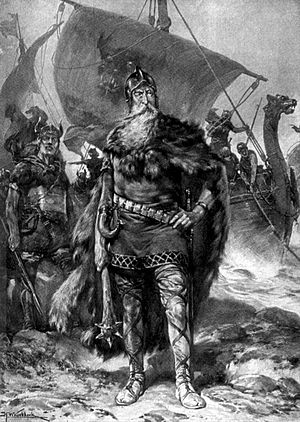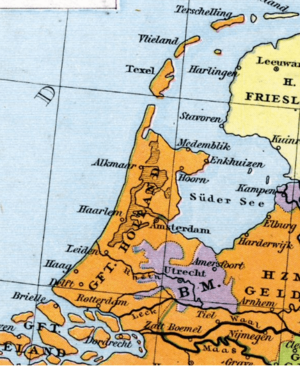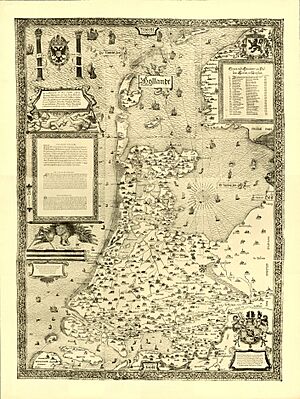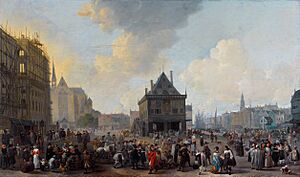County of Holland facts for kids
Quick facts for kids
County of Holland
|
|||||||||
|---|---|---|---|---|---|---|---|---|---|
| 1091/1190–1431/1795 | |||||||||
|
Motto: "Vigilate Deo confidentes" (Latin)
"Watch, trusting in God" |
|||||||||

The County of Holland around 1350.
|
|||||||||
| Status | State of the Holy Roman Empire part of the Burgundian Netherlands (1433–1482) part of the Habsburg Netherlands (1482–1581) part of the Dutch Republic (1581–1795) |
||||||||
| Capital | The Hague | ||||||||
| Common languages | Old Frisian Old Dutch Middle Dutch Dutch |
||||||||
| Religion | Catholic Church Dutch Reformed |
||||||||
| Government | Feudal monarchy | ||||||||
| Count | |||||||||
|
• 880–896
|
Gerolf (first) | ||||||||
|
• 1555–1581
|
Phillip II (last) | ||||||||
| Stadtholder | |||||||||
|
• 1433–1440
|
Hugo (first) | ||||||||
|
• 1672–1702
|
William III (last) | ||||||||
| Legislature | States | ||||||||
| Historical era | Middle Ages, Renaissance, Modern | ||||||||
|
• Established
|
11th century | ||||||||
| 26 July 1581 | |||||||||
| 18 January 1795 | |||||||||
|
|||||||||
| Today part of | Netherlands | ||||||||
The County of Holland was a powerful state in Europe for many centuries. It started as part of the Holy Roman Empire. Later, it became a key part of the Dutch Republic. This republic was a very important country from 1581 until 1795.
The land of the County of Holland is now mostly the North Holland and South Holland provinces in the Netherlands. This area was one of the first in the region to grow strong in trade, culture, and technology.
Contents
What's in a Name?
The oldest records called this area Frisia. This was the land west of the Vlie river. Before 1101, the rulers were called "Frisian counts." But in 1101, Floris II, Count of Holland was called "Floris, Count of Holland." This is the first time "Holland" was used for the count's title.
The name "Holland" likely comes from the Old Dutch words holt lant, meaning "wood land." The counts used this title for a long time. Later, they added other areas to their title, like "Count of Holland and Zeeland, lord of Friesland."
A Look Back: Holland's Story
Early Beginnings
Around the year 800, a huge empire called the Frankish Empire covered much of Europe. Local areas were ruled by a count. These counts were given land by the king. Over time, these land grants became inherited by their children. This system is called feudalism.
The Frankish kingdom often split among the king's children. This caused many fights. Also, Viking raids made things even harder. In 840, Emperor Lothair I gave land in Frisia to Viking brothers to stop their attacks. This area later became part of Lotharingia.
In 885, the Viking rule ended. A Frisian leader named Gerolf of Holland gained control of a large part of the area. In 889, the East Frankish king officially gave Gerolf these lands. This was because the king needed strong leaders to fight off the Vikings. Gerolf's family became the first Counts of Holland.
In 922, King Charles the Simple gave land to Dirk I, Count of Holland. This was thanks for Dirk's help in a battle. Dirk then founded Egmond Abbey, the oldest monastery in Holland.
Becoming an Important State
The Counts of Holland slowly became more powerful. In 938, Dirk II, Count of Holland married a princess from Flanders. This showed how important the Holland counts were becoming.
For a long time, Holland was quite independent from the Holy Roman Empire. The count of Holland was like a military leader. His job was to stop Viking raids. In 985, Emperor Otto III gave more land to Count Dirk II.
In 993, Count Arnulf, Count of Holland was killed fighting against local people. His son, Dirk III, Count of Holland, took over. Dirk III later went on a trip to Jerusalem. When he came back, he built a castle in Vlaardingen. From this castle, he made ships pay a toll to pass.
In 1018, the Emperor sent an army to stop Dirk III. But Dirk's Frisian fighters surprised the army in a swamp. This was the Battle of Vlaardingen. Dirk III won and even captured the Duke of Lower Lorraine. Because Holland was important for fighting Vikings, the Emperor let Dirk keep his lands. Dirk continued to expand his territory.
Later, Dirk IV, Count of Holland also fought against the Emperor. He was killed in 1049. His brother, Floris I, Count of Holland, took over. Floris expanded the territory even more. He added an area called Holtland (Woodland). This name soon became used for the whole county.
In 1101, the name "Holland" officially appeared in a document for the first time. Over the next two centuries, Holland grew stronger. The counts conquered most of Zeeland. They also fought a long war against the "West-Frisians" in North Holland. In 1289, Count Floris V finally won this war. After that, the county was known as the County of Holland and West Friesland.
New Rulers and Great Trade
Between 1350 and 1490, Holland had many conflicts called the Hook and Cod Wars. These were fights over who should be count. But they were also about power struggles between the cities and the noble families. The "Cod" group usually represented the cities, while the "Hook" group represented the nobles.
Eventually, Philip the Good, the Duke of Burgundy, took control of Holland. Many noblemen in Holland invited him to do this. They wanted Holland to join the strong trading system of Flanders.
Under the Burgundian rulers, Holland's trade grew very fast. Especially shipping and transport became important. Holland's ships even defeated the powerful Hanseatic League fleets. Amsterdam became a major trading port in Europe. It imported grain from the Baltic region and sold it to cities in Belgium, France, and England. This grain trade was vital because Holland could not grow enough food for its people.
In 1506, Charles V, Holy Roman Emperor, became the ruler. But in 1515, he left to become King of Spain. He put his relatives in charge of Holland. Holland still kept its own government and laws. But the Burgundians also created a larger government for all the Netherlands.
Revolt and the Dutch Republic
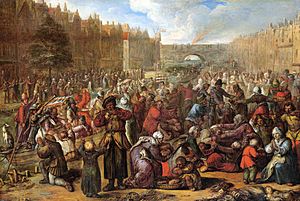
In the 16th century, the Protestant Reformation spread quickly. Many people in Holland became Protestants, especially Calvinists. In a trading society like Holland, people believed in freedom and tolerance. However, the Catholic rulers, Charles V and Philip II of Spain, wanted to stop Protestantism. They saw it as a threat. They started harsh persecutions.
In 1566, there was a movement called the Beeldenstorm. People destroyed statues and religious art in Catholic churches. This led to a big revolt. William the Silent became the leader of this uprising. It turned into the Eighty Years' War against Spain.
Holland and six other provinces became an independent country. It was called the Republic of the Seven United Provinces. William the Silent's leadership helped keep the Dutch together. A key moment was when Holland and Zeeland were taken over by the "Watergeuzen" in 1572. These were Calvinist sailors and pirates who fought for freedom.
The new Dutch Republic signed the Act of Abjuration. This document removed Philip II as their ruler. Holland became the most important part of this new country. In the 17th century, during the Dutch Golden Age, the Dutch Republic was the richest nation in the world.
Many big cities were in Holland, like Amsterdam, Rotterdam, and The Hague (the capital). Merchants from Holland sailed all over Europe. Traders from other countries came to Holland to do business. Because Holland was so important, many Europeans called the whole country "Holland." This led to a "Hollandification" of the other provinces. The Dutch language spoken in Holland became the standard language for the whole country.
The County of Holland officially ended in 1795. This happened when the Batavian Revolution created the Batavian Republic. Later, in 1813, Holland became a province of the new Kingdom of the Netherlands. In 1840, Holland was divided into the two provinces we know today: North Holland and South Holland.
Where Was Holland?
The County of Holland covered roughly the same area as today's North Holland and South Holland provinces. It also included a small part of North Brabant. Some islands like Terschelling and Urk were also part of it.
In the early Middle Ages, much of this area was covered by peat bogs. These bogs were good for fuel. But they limited the land for farming. Around 950, people started to reclaim small parts of these bogs. In the 11th century, a "Great Reclamation" began. The Counts of Holland and the bishops of Utrecht led this effort. They drained large areas of land.
Before this reclamation, the borders between Holland and the bishopric of Utrecht were not clear. But as land was reclaimed, the Counts of Holland gained more control.
Images for kids
-
Count Willem II of Holland Granting Privileges by Caesar van Everdingen and Pieter Post, 1654.
See also
- Count of Holland
- Counties of the Holy Roman Empire



